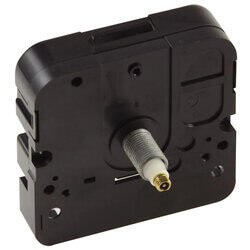Contemporary Electronic Clock MovementsClock movements are, in a feeling, the innards of watches, keeping track of passing time and aiming the hands to the best position on the dial continually. Digital clock movements perform these functionalities through electric ways rather than via the mechanical ways of times previous. Additionally, electronics makes it a lot easier than technicians to broaden timekeeping capacity as well as other attributes, consisting of prolonging the regular cycle showed.Nonetheless, mechanical clock movements bring a lengthy custom as well as background with much development, and they are the structure upon which contemporary timepieces are made. Mechanical power was produced by a hanging weight or a coiled springtime, and also it applied the rotational force used to place the hands at the best minute (with the help of pendulums and also escapement mechanisms). This worked well and also with precision, however the parts were large and needed to be periodically reset.The modern motor design uses electromotive force (voltage) to cause a quartz crystal to create a rapid pulse-stream, getting rid of most of the mechanical components. Digital registers collect pulse counts, and software tracks these registers in establishing when to cause changes in hand placement. No pendulums or escapements are needed to manage the timing.The above covers basic timekeeping for both mechanical as well as digital movements. We currently look to the bells as well as whistles (time expansions, weather sensations, and uniqueness) that digital motors are easily capable of, however which mechanical ones might or may not have the ability to carry out.The pre-owned generally goes unnoticed-- unless the wrist watch is in the bedroom (or library). The standard motion is a tick (as the hand advances to the following mark) and afterwards remainder, as well as the tick is typically distinct. However, you can get a clock movement that sustains a constant move (and also entirely silent) second hand.The most common clock cycle is 12 hrs (the display equals for twelve noon as well as twelve o'clock at night). Yet you can order an electric motor that cycles every 24 hr instead (needing you to get a calibrated dial also). To differentiate day hrs from night, the dial displays an extra lots numbers around its area; the numbers appear either in pairs or spread out, to make sure that the hr hand revolves once a day rather than twice.Currently, you can additionally have a cycle longer than 1 day-- assume a week or month. For the former, the specifically adjusted dial has 7 regions in the center with a various day of the week published in each. An extra hand points to the day, rotating to the next day at midnight.For the monthly cycle, there are 31 "dates" published around the area, come together with the numbers showing the hrs. (Various colors and/or different radiuses are used to differentiate quickly.) Below, the additional hand is about the same length as the minute hand, and revolves to the following day at twelve o'clock at night.The means a movement is allowed to display climate phenomena (humidity, stress, temperature level) is by using sensors. The dial reveals a variety with two ends (a maximum as well as minimum value), and the solitary hand revolves within the variety based on the existing analysis of the sensor.A pair popular uniqueness are chimes (appearing different familiar tunes) and aesthetic pendulums. The timing of the motor manages the triggering of the chimes, generally when an hour, in some cases every quarter hr, and in some cases following the hr harmonize a hr matter. Non-functional pendulums that oscillate just for program, supply a sort of nostalgia and/or synthetic credibility to the wrist watch.The clockmaker of today has a great deal even more versatility in creating and also developing intriguing as well as also amazing works. Loosened up from the restrictions of the old mechanical watches, the opportunities seem unrestricted. This all transpires via the technology of modern-day digital clock movements.
